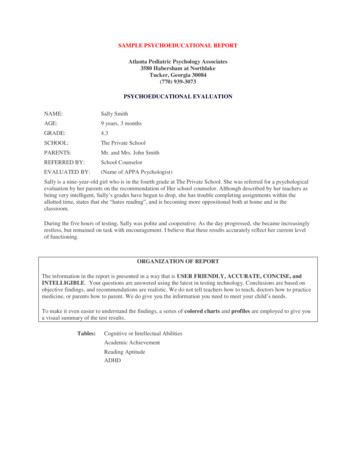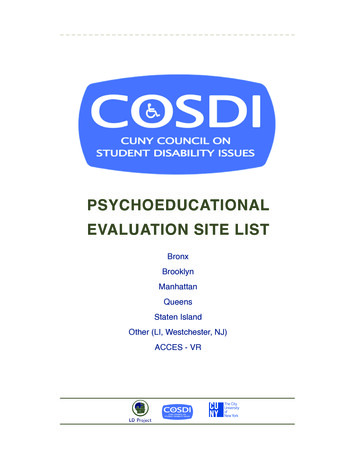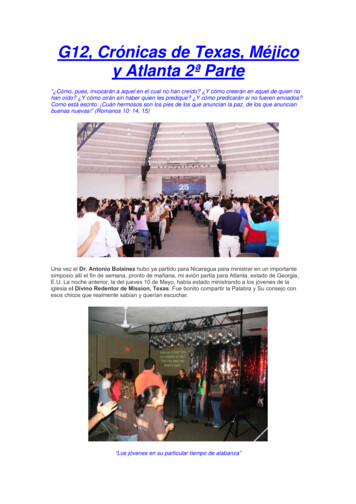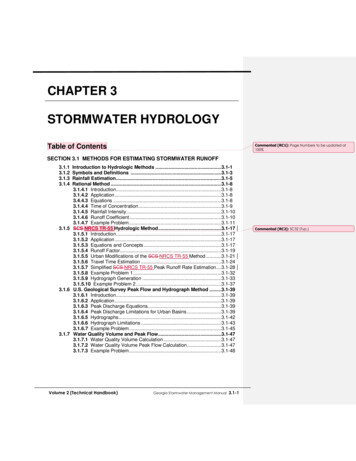
Transcription
SAMPLE PSYCHOEDUCATIONAL REPORTAtlanta Pediatric Psychology Associates3580 Habersham at NorthlakeTucker, Georgia 30084(770) 939-3073PSYCHOEDUCATIONAL EVALUATIONNAME:Sally SmithAGE:9 years, 3 monthsGRADE:4.3SCHOOL:The Private SchoolPARENTS:Mr. and Mrs. John SmithREFERRED BY:School CounselorEVALUATED BY:(Name of APPA Psychologist)Sally is a nine-year-old girl who is in the fourth grade at The Private School. She was referred for a psychologicalevaluation by her parents on the recommendation of Her school counselor. Although described by her teachers asbeing very intelligent, Sally’s grades have begun to drop, she has trouble completing assignments within theallotted time, states that she “hates reading”, and is becoming more oppositional both at home and in theclassroom.During the five hours of testing, Sally was polite and cooperative. As the day progressed, she became increasinglyrestless, but remained on task with encouragement. I believe that these results accurately reflect her current levelof functioning.ORGANIZATION OF REPORTThe information in the report is presented in a way that is USER FRIENDLY, ACCURATE, CONCISE, andINTELLIGIBLE. Your questions are answered using the latest in testing technology. Conclusions are based onobjective findings, and recommendations are realistic. We do not tell teachers how to teach, doctors how to practicemedicine, or parents how to parent. We do give you the information you need to meet your child’s needs.To make it even easier to understand the findings, a series of colored charts and profiles are employed to give youa visual summary of the test results.Tables:Cognitive or Intellectual AbilitiesAcademic AchievementReading AptitudeADHD
Sample APPA ReportSally Smith (not real name)Page - 2Summary and ConclusionsIn our sample case, Sally was found to have severe problems with Visual Processing (“letter reversals”) and veryslow Processing Speed. These processing disabilities have resulted in a Specific Learning Disability in Reading. TheReading Aptitude profile summarizes her strengths and weaknesses in reading and should be useful to her teachersin planning a remediation program.Sally also has an Attention Deficit Hyperactivity Disorder and is experiencing significant levels of anxiety. Herdeteriorating school performance is the result of the combined effects of a Specific Learning Disability, ADHD, andanxiety.Diagnosis:Attention Deficit Hyperactivity Disorder (ADHD)Generalized Anxiety DisorderSpecific Learning Disability in Reading (Dyslexia)Psychological Processing Disorders:Visual Processing (“letter reversals”)Processing Speed: (Rapid Picture Naming)Evaluation ProcessThe tests listed below are some that are utilized by APPA psychologists.Gordon Diagnostic SystemTest of Variables of Attention (TOVA): Auditory versionTest of Information Processing (TIPS)Woodcock-Johnson IVTests of Cognitive Ability (WJ IV COG)Tests of Oral Language (WJ IV OL)Tests of Achievement (WJ IV ACH)Wechsler Intelligence Scale for Children-V (WISC-V): SimilaritiesWechsler Adult Intelligence Scale – IV (WAIS-IV)Kaufman Test of Educational Achievement-3 (KTEA-3):Wechsler Individual Achievement Test-III (WIAT-III): XXXWide Range Assessment of Memory and Learning II (WRAML II): Verbal Learningand Sound-Symbol LearningComprehensive Test of Phonological Processing (CTOPP): ElisionJordan Left-Right Reversals Test – 3rd EditionThe Beery-Buktenica Developmental Test of Visual-Motor Integration (VMI)Minnesota Multiphasic Personality Inventory-Adolescent (MMPI-A)Reynold's Child Depression Scale 2Revised Children's Manifest Anxiety Scale 2Reynold’s Adolescent Depression Scale 2Piers-Harris Children's Self-Concept Scale 2Conners QuestionnaireChild Behavior ChecklistNelson-Denny Reading Test (Form G)Millon Adolescent Personality Inventory (MAPI)Symptom Checklist 90 Revised (SCL-90-R)Brown Attention Deficit Disorder Scale for AdolescentsBrown Attention Deficit Disorder Diagnostic Form for AdolescentsBrown Attention Deficit Disorder Scale for AdultsBrown Attention Deficit Disorder Diagnostic Form for AdultsAutism Spectrum Rating Scale (ASRS)
Sample APPA ReportSally Smith (not real name)Page - 3Behavior Rating Inventory of Executive Function (BRIEF)Wechsler Preschool and Primary Scale of Intelligence (WPPSI-IV)Thematic Apperception TestIncomplete Sentences TestFINDINGSThis section presents what was found during the evaluation.Intellectual Potential was measured with the Woodcock-Johnson IV Tests of Cognitive Abilities (WJ IV). TheWJ IV is a well normed individual intelligence test that, in addition to yielding a total score, has multiple subscalesthat measure the many abilities which are necessary for learning. Sally’s Broad Cognitive Ability Score (similar toan IQ) of 114 places her in the high average range at the 82nd percentile, i.e., she did as well or better on this testas 82 of 100 children her age.There is a problem inherent in all IQ scores, (WJ IV, WISC-V, etc.), that are derived from an average of severalsubtests. If there is too great a range of scores, their "average" loses its usefulness as a means of summarizing themany abilities that combine to form human intelligence. A better approach is to consider each of the cognitiveabilities separately in making predictions of potential. Human intelligence is much too complex to be compressedinto any one score. Below are the cognitive (intellectual) abilities measured by the WJ IV.Fluid Reasoning or the Ability to Think Logically: This is what most people think of when they think of higherlevel intelligence. How the person is able to process information and use it to solve abstract problems. Fluidreasoning is an area of great strength for Sally. On a test of visual fluid reasoning that required her to utilizeanalysis and synthesis to solve puzzles, she placed in the superior range at the 97th percentile. She also placed inthe superior range on the Similarities subtest from the WISC V, which indicates superior verbal fluid reasoning.Sally has a tremendous aptitude for abstract thinking and reasoningComprehension and Knowledge: This is a measure of how much the child has learned and remembered. One of thebetter measures of Comprehension and Knowledge is vocabulary. Sally’s scores on the Verbal Comprehension andPicture Vocabulary tests indicate that she has an excellent vocabulary.Long-Term Retrieval (Learning and Long-Term Memory): An excellent feature of the WJ IV is its ability to test howwell a person can learn new material and remember it. On the Story Recall subtest, Sally listened to a story and thenrepeated it, (i.e., one-trial verbal learning). She placed in the low average range on this test (19%), and on the VisualAuditory Learning subtest, Sally placed also in the low average range at the 20th percentile. She also placed in thelow average range on the Verbal Learning subtest from the WRAML II (. These findings indicate that Sally hasdifficulty learning and remembering new information).Short-Term Working and Rote Memory: All learning is dependent upon short-term memory. An example is beingable to remember a phone number long enough to dial it. The WJ III measures both working and rote short-termmemory. Sally placed in the average range on all tests of short-term memory.Cognitive Processing Speed: How quickly the person works on easy, routine tasks. On the Visual Matching subtest,Sally placed at the lower limit of the low average range (SS 80, 9%). This may indicate the presence of ADHD asa slow rate of processing information is associated with this disorder, or it may reflect the problems with visualprocessing noted above. She also did very poorly on a test of rapid naming (Rapid Picture Naming 5%). Rapidnaming if very important for reading and weaknesses can indicate the presence of a serious reading problem.Sally has a Psychological Processing Disorder for Processing Speed.Auditory Processing: This refers to the ability to hear and manipulate the sounds which combine to form words. It isa skill which is very important in spelling and learning new words by hearing them, e.g., learning a foreign language.
Sample APPA ReportSally Smith (not real name)Page - 4It is not the same as Listening Comprehension which refers to the ability to grasp the meaning of what one hears.Sally’s auditory processing abilities are at the lower limit of the average range.Visual Processing: Being able to accurately see letters and numbers is an essential first step for reading and math,and the ability to recognize and remember objects that are seen is important for a broad range of tasks—art, drafting,architecture, or simply recalling the faces of friends. Sally placed in the high average range on the visual processingsubtest from the WJ IV (Visual Closure) and also did well on a test of her ability to copy designs (VMI). However,because the WJ IV tests of visual processing do not measure the tendency to see numbers, letters, and wordsbackward, the Jordan Left-Right Reversal Test was administered. Sally did very poorly on the Jordan; placing at the0% for both Accuracy and Errors. This is a serious deficit in a child her age and suggests the presence of visuallybased dyslexia.Sally has a Psychological Processing Disorder for Visual Processing: Sequencing that is oftenreferred to as a “letter reversal problem”.Summary: Sally has high average intelligence (GIA or “IQ” 114). Her greatest strength is fluid reasoning(higher order intelligence). She has several other strengths, but Psychological Processing Disorders were foundfor Processing Speed and Visual Processing (“letter reversals”). These disorders are likely the reason that shehas trouble “completing assignments” and “reading”.Findings such as the above are quite common in children referred to us for academic problems. They may be verybright in some areas but have significant weaknesses in others. As you can see from this summary, we augment thebasic intelligence test with other instruments to assure that all of the basic abilities are adequately covered.Making a differential diagnosis between LD, ADHD, ODD, and Emotional Problems is not an easy task. It can onlybe done if the appropriate tests are used.The graph on the following page shows the results of the Intellectual (Cognitive) Testing. The goalis to make the findings easy to understand. To do this, all test scores are presented in graphicformat and then described in the text.
Sample APPA ReportSally Smith (not real name)Page - 5COGNITIVE or INTELLECTUAL ABILITIES (WJ IV)AGE NORMSName Sally SmithAge: 9-years 06070758091100GENERAL INTELLIGENCETests82%FLUID REASONING(Higher Order Intelligence)Number Series*97%WISC-V hension*Picture Vocabulary95%90%LONG-TERM RETRIEVAL(Learning and Long-Term Memory)Story Recall *25%WRAML II: VerbalLearning22%SHORT-TERM MEMORYVerbal Attention *Sentence RepetitionTIPS Visual (Looking)TIPS Verbal(Listening)30%35%26%25%COGNITIVE PROCESSING SPEEDLetter-PatternMatching*Rapid Picture Naming9%5%AUDITORY PROCESSINGPhonologicalProcessing25%VISUAL PROCESSINGVisualization *Visual-Motor: VMIJordan: Accuracy79%85%Jordan: Error0%0%LowAverageHigh* Used to calculate the GIA. Very Low Range SS 69 and below (0%-2%); Low Range SS 70 to 79 (3% to 8%); Low Average Range SS 80 to 89 (9%to 24%); Average Range SS 90 to 110 (25% to 75%); High Average SS 111 to 120 (76% to 91%); Superior Range SS 121 to 130 (92% to 97%); VerySuperior SS 131 and (98% to 99.9%)
Sample APPA ReportSally Smith (not real name)Page - 6Academic AchievementSally’s achievement scores are summarized in the graph that follows. They reveal that Sally is a very poor readerand should be diagnosed as having a Specific Learning Disability in Reading. The finding that her ListeningComprehension score is superior indicates that she does not have a generalized receptive language problem but onespecific to reading. Good ability was also found in Expressive Language (oral and written) and Math.The conclusion is that a SLD in Reading is playing a significant role in her declining school performance, especiallyas she is attending a highly competitive private institution. The causes of this reading problem are shown on in thepreceding graph and the one that follows.Sally has a Specific Learning Disability in Reading, (i.e., Dyslexia).ACADEMIC ACHIEVEMENT: WJ IVAge Norms: Compares Student to Peers the same AgeName: Sally SmithTESTS%Word AttackLetter-WordIdentification *PassageComprehension *Oral ReadingReading RecallSentence ReadingFluency *10%15%092025Age: 9-years 3-months50%3040READING60707580918%7%10%5%ORAL LANGUGUAGE(Listening & Speaking)Oral ExpressionStory Recall (OralExpression)Picture VocabularySentence RepetitionOral Expression(Composite s (ListeningComprehension)Oral Expression25%90%35%(40%)Listening Comprehension80%WRITTEN LANGUAGESpelling *Writing Samples *Sentence WritingFluency *20%40%35%MATHEMATICSCalculation *Applied Problems *Math Facts Fluency *85%95%40%LowAverageHigh100
Sample APPA ReportSally Smith (not real name)Page - 7Reading and Writing AptitudeReading and writing are comprised of many basic abilities working together. To simply give a child an achievementtest, find a weakness in reading or writing, and report that the child has a learning disability, offers little help to theteacher or parent. In addition to documenting IF a child has a problem, a good evaluation explains WHY.The Reading and Writing Aptitude Graph shows why Sally is struggling in reading. This is because she has slowprocessing speed and trouble processing visual information, (i.e., she “makes sense of” information very slowly andreverses letters). It is not unusual to find that parents and teachers are unaware that a bright child such as Sally is apoor reader. Such children are often very good a compensating for reading weaknesses on short
SAMPLE PSYCHOEDUCATIONAL REPORT Atlanta Pediatric Psychology Associates 3580 Habersham at Northlake Tucker, Georgia 30084 (770) 939-3073 PSYCHOEDUCATIONAL EVALUATION NAME: Sally Smith AGE: 9 years, 3 months GRADE: 4.3 SCHOOL: The Private School PARENTS: Mr. and Mrs. John Smith REFERRED BY: School Counselor EVALUATED BY: (Name of APPA











